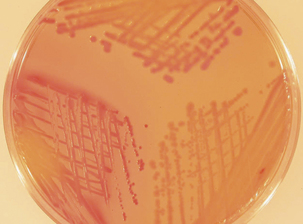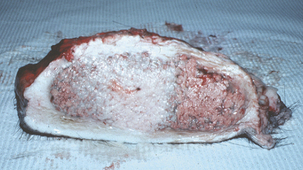Chapter 14 Miscellaneous Coliforms: The Genera Klebsiella, Enterobacter, and Citrobacter
Members of the family Enterobacteriaceae ferment lactose, producing acid and gas, with the former evidenced in the pink colonies they produce on MacConkey agar (Figure 14-1). Colonies of Klebsiella, Enterobacter, and Citrobacter on blood agar are nonhemolytic, shiny, round, gray with entire margins, and 2 to 3 mm diameter after 24-hour incubation at 37° C. All are facultatively anaerobic, oxidase-negative, gram-negative rods. Infections associated with these organisms are opportunistic.

FIGURE 14-1 Lactose-fermenting colonies on MacConkey agar. Klebsiella, Enterobacter, and Citrobacter spp.
(Courtesy Karen W. Post.)
THE GENUS KLEBSIELLA
The genus Klebsiella contains nonmotile encapsu lated organisms that are Voges-Proskauer positive, hydrolyze urea, ferment inositol, and utilize citrate, but fail to produce ornithine decarboxylase or hydrogen sulfide (Table 14-1). The three species currently in the genus are Klebsiella pneumoniae, Klebsiella oxytoca, and Klebsiella granulomatis. Klebsiella pneumoniae is divided into subspecies ozaenae, pneumoniae, and rhinoscleromatis. The animal pathogenic species are K. pneumoniae ssp. pneumoniae and K. oxytoca.
Diseases and Epidemiology
Bovine mastitis attributed to K. pneumoniae ssp. pneumoniae is economically significant, occurring as peracute disease in individual animals or as outbreaks of acute disease. Case fatality rates may be as high as 80%. Sawdust and shavings are major reservoirs of klebsiellae, and disease is most common in dairy cattle housed during the winter months on sawdust bedding. It is also diagnosed in animals kept in confinement on dry lots. Mastitis is associated with gross contamination of udder and teats with feces and bedding, and is frequently seen within a few days of calving. Moist bedding promotes environmental replication of the organism, and trauma induced by improperly functioning milking machines predisposes the udder to infection. Sporadic cases of caprine and porcine mastitis caused by K. pneumoniae have also been reported (Figure 14-2).
Klebsiella spp. account for 3% to 7% of all nosocomial bacterial infections of humans in the United States. The urinary tract is the most common site of infection. In pediatric wards, Klebsiella spp. are often associated with neonatal septicemia. K. granulomatis is the etiologic agent of granuloma inguinale, a sexually transmitted disease characterized by anogenital granulomatous lesions.
Stay updated, free articles. Join our Telegram channel

Full access? Get Clinical Tree




